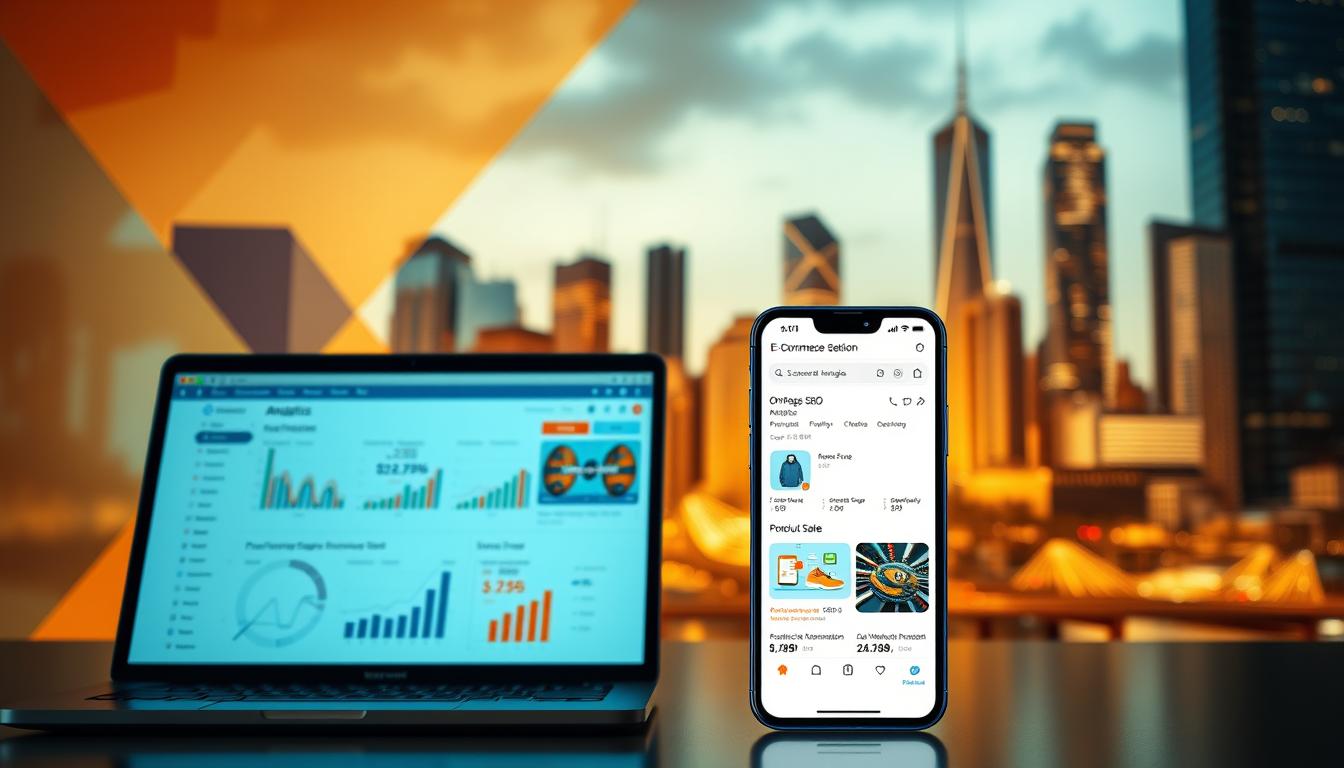Are you struggling to get your online store noticed in the crowded e-commerce market? With so many businesses competing for attention, it’s becoming increasingly difficult to stand out. Effective website optimization is crucial for driving sales and growing your business.
Optimizing your online store involves more than just listing products. It requires a strategic approach to e-commerce SEO that enhances your store’s visibility on search engines. By focusing on on-page SEO for online stores, you can improve your search engine rankings and provide a better user experience for your customers.
Key Takeaways
Table of Contents
- On-page SEO is crucial for online store visibility.
- Optimizing product titles and descriptions improves search engine rankings.
- A well-optimized website enhances user experience.
- E-commerce SEO strategies drive sales and business growth.
- Website optimization is key to standing out in a crowded market.
On-page SEO for Online Stores: The Fundamentals
To thrive in the digital age, e-commerce businesses need to focus on optimizing their websites for search engines. On-page SEO is a critical component of this optimization, as it helps search engines understand the structure and relevance of an online store’s content.
Why E-commerce Businesses Need Strong SEO
E-commerce businesses need strong SEO to improve their online visibility, drive more traffic to their websites, and increase sales. Effective SEO strategies can help online stores outrank their competitors and reach their target audience more effectively.
- Increase online visibility
- Drive more traffic to the website
- Boost sales and revenue
How Search Engines View E-commerce Websites
Search engines view e-commerce websites as complex entities with multiple pages, products, and categories. To crawl and index these sites effectively, search engines rely on clear site architecture and relevant meta tags. Ensuring that an e-commerce website is crawlable and indexable is crucial for its visibility in search engine results.
The ROI of Investing in On-page SEO
Investing in on-page SEO can yield significant returns for e-commerce businesses. By improving their website’s visibility and driving more traffic to their site, online stores can increase their sales and revenue. Studies have shown that businesses that invest in SEO can expect to see a return on investment (ROI) of up to 500% or more.
Essential On-page SEO Elements for E-commerce Websites
For e-commerce websites, on-page SEO is not just important – it’s essential for driving sales and revenue. By optimizing key elements on your website, you can significantly improve your search engine rankings and provide a better experience for your customers.
Optimizing Product Titles and Descriptions
Product titles and descriptions are crucial for both search engines and customers. They help search engines understand what your product is about and can entice customers to make a purchase. To optimize them, include relevant keywords naturally, ensure they are descriptive, and make sure they are compelling enough to drive sales.
For example, instead of using a generic title like “Women’s Running Shoes,” use a more descriptive title like “Nike Women’s Air Zoom Pegasus Running Shoes – Lightweight and Breathable.” This not only includes relevant keywords but also provides more details about the product.
Creating SEO-Friendly URL Structures
SEO-friendly URLs are clean, descriptive, and include target keywords. They should be easy for both users and search engines to understand. For instance, a URL like “example.com/nike-womens-air-zoom-pegasus-running-shoes” is more SEO-friendly than “example.com/product123.”
Implementing Proper Heading Tags and Meta Information
Heading tags (H1, H2, H3, etc.) help structure your content and highlight important keywords. Your product page should have one H1 tag that includes the product name, and subsequent headings should be used to break up the content and emphasize key points.
Meta information, including meta titles and descriptions, should also be optimized with relevant keywords. The meta title should be a concise version of your H1 tag, and the meta description should be a compelling summary of your product page, enticing users to click through from search engine results.
Image Optimization for Online Stores
Images are crucial for e-commerce websites, but they can also slow down your site if not optimized properly. Use descriptive file names that include target keywords, and make sure your alt tags are descriptive and include relevant keywords. Compressing images can also help improve page load times.
Enhancing User Experience Signals
User experience signals, such as page speed and mobile responsiveness, play a significant role in SEO. Ensure your website is mobile-friendly and loads quickly. A slow website can lead to higher bounce rates and lower search engine rankings.
| SEO Element | Description | Best Practice |
|---|---|---|
| Product Titles | Descriptive titles that include target keywords | Include brand, product name, and key features |
| URL Structure | Clean and descriptive URLs | Use keywords and hyphens to separate words |
| Heading Tags | Structured content with H1, H2, H3 tags | Use H1 for product name and subsequent tags for content structure |
| Image Optimization | Descriptive file names and alt tags | Use keywords and compress images for faster load times |
Technical On-page SEO Strategies for Online Shops
Enhancing your online store’s technical SEO can significantly boost its visibility and conversion rates. Technical on-page SEO involves optimizing your website’s backend structure and elements to improve search engine crawling, indexing, and ranking.
Improving Site Speed and Performance
Site speed is a critical factor in SEO and user experience. A slow-loading website can lead to higher bounce rates and lower search engine rankings. To improve site speed, optimize images by compressing them without compromising quality, minify CSS and JavaScript files, and leverage browser caching.
Utilizing tools like Google PageSpeed Insights can help identify areas for improvement. Ensuring that your website’s hosting is reliable and considering the use of a Content Delivery Network (CDN) can also enhance performance.
Mobile Optimization for E-commerce
With the majority of online shoppers using mobile devices, having a mobile-optimized website is no longer optional. Ensure that your e-commerce site is responsive, meaning it adapts seamlessly to different screen sizes and devices.
Mobile optimization includes having fast loading speeds on mobile, easy navigation, and readable content without the need for zooming. Google’s mobile-first indexing means that the mobile version of your site is considered the primary version.
Structured Data and Schema Markup for Products
Structured data and schema markup help search engines understand the content and context of your web pages, including product pages. This can enhance your search engine listings with rich snippets, such as product reviews and prices.
Implementing schema markup for products involves adding specific code to your product pages. This can be done manually or through plugins available for popular e-commerce platforms like Shopify and WooCommerce.
Internal Linking Best Practices
Internal linking is crucial for helping search engines understand your site’s structure and for guiding users to relevant content. Use descriptive anchor text for your links and ensure that they are relevant to the content they link to.
A well-planned internal linking strategy can also help distribute link equity throughout your site, potentially boosting the rankings of key pages.
Fixing Common E-commerce SEO Technical Issues
Common technical SEO issues in e-commerce include duplicate content, poor URL structures, and crawl errors. Regularly auditing your site can help identify and fix these issues.
Use tools like Google Search Console to monitor your site’s performance and identify technical SEO issues. Addressing these issues promptly can prevent negative impacts on your search engine rankings.
| Technical SEO Issue | Impact | Solution |
|---|---|---|
| Duplicate Content | Confuses search engines, dilutes link equity | Use canonical URLs, avoid duplication |
| Poor URL Structures | Makes it hard for search engines to understand site hierarchy | Use descriptive, concise URLs |
| Crawl Errors | Prevents search engines from indexing important pages | Fix broken links, improve site architecture |
Content Optimization Techniques That Drive Sales
In the competitive world of e-commerce, content optimization techniques are essential for driving sales and growth. By optimizing their content, online stores can improve their search engine rankings, attract more customers, and ultimately increase their conversion rates.
Creating Compelling Product Descriptions That Rank
Product descriptions play a crucial role in e-commerce SEO. To create compelling product descriptions that rank, online stores should focus on writing keyword-rich and engaging content. This involves using relevant keywords, such as “optimizing product pages” and “seo meta tags for online shops,” naturally throughout the description.
For example, a well-optimized product description for a running shoe might include keywords like “lightweight running shoes” and “breathable mesh upper.” By incorporating these keywords, online stores can improve their product pages’ visibility in search engine results.
Developing Category Pages That Convert and Rank
Category pages are another critical component of e-commerce SEO. To develop category pages that convert and rank, online stores should ensure that their pages are well-structured, easy to navigate, and contain relevant keywords. This can be achieved by using SEO-friendly URLs, meta titles, and descriptions.
| Category Page Element | Optimization Tip |
|---|---|
| Meta Title | Include target keywords, such as “women’s clothing” or “men’s accessories.” |
| Meta Description | Write a compelling description that includes target keywords and entices users to click. |
| Header Tags | Use H1, H2, and H3 tags to structure content and highlight key categories. |
Leveraging User-Generated Content for SEO
User-generated content, such as customer reviews, can significantly enhance an online store’s SEO. By encouraging customers to leave reviews, online stores can increase their content’s relevance and attract more customers.

Blog Content Strategies for Online Stores
Blog content is a valuable tool for online stores looking to improve their SEO. By creating high-quality, SEO-friendly blog content, online stores can attract more customers and drive sales.
Keyword Research for E-commerce Content
Effective keyword research is critical for e-commerce content optimization. By identifying relevant and high-volume search terms, online stores can create content that resonates with their target audience and improves their search engine rankings.
Conclusion: Measuring Success and Taking Your SEO Further
As we’ve explored throughout this article, on-page SEO for online stores is crucial for improving visibility, driving sales, and growing your e-commerce business. To measure the success of your On-page SEO efforts, focus on tracking key performance indicators (KPIs) such as search engine rankings, organic traffic, and conversion rates.
Regularly monitoring these metrics will help you understand the impact of your e-commerce SEO strategy and identify areas for improvement. Stay up-to-date with the latest best practices and algorithm updates to continually refine your website optimization approach.
By following the strategies outlined in this article and staying committed to your On-page SEO efforts, you can improve your online store’s visibility, drive more sales, and achieve long-term success in the competitive e-commerce landscape.

